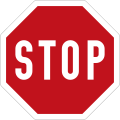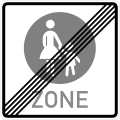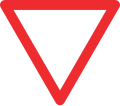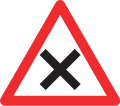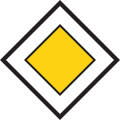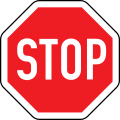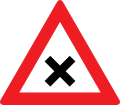Right of way
For the handling of road traffic at crossings and junctions apply
- in Germany: right of way
- in Switzerland and Liechtenstein: right of way
- in Austria: priority rules
On the streets of most countries with right-hand traffic, the basic rule is right before left . The one that comes from the right, has the right of way (D), priority (CH / FL) and priority (A), the other shall wait.
If the traffic conditions require it, the right of way is regulated by appropriate signs . Road users must be able to clearly see which rule applies from both directions. So there is always a negative (obligation to wait) and a positive (right of way) traffic sign. In most cases, the obligation to wait is made clearer by road markings.
Internationally, the traffic rules are regulated in the Vienna Convention on Road Traffic .
history
This rule has its origin in shipping (see rules of avoidance between watercraft ). On the ships of the Vikings , the rudder or the tiller was attached to the right side of the boat (mainly due to right-handed people ) and was operated on the aft deck . Since there are no pulleys or similar at this time . the rudder could only be operated with direct extension. The helmsman thus stood sideways on the quarterdeck with his face to the right ( starboard ) and his back to the left ( port ). Since the helmsman is now looking to the right, he can observe any traffic in this direction and can therefore give way. What is happening in his back is difficult for him to see. Therefore he got right of way over the ships sailing there.
Germany
The right of way applies to vehicles and their relationship to each other on intersecting lanes. Riders, drivers of horses and drivers and drivers of cattle are on an equal footing with vehicle drivers. In the remaining cases, the term priority is used.
Right of way and priority are regulated by the following sections of the Road Traffic Act (StVO):
Section I: General traffic rules
§ 6 Driving past
"If you want to drive past a narrow lane, an obstacle in the lane or a stopping vehicle, you have to let oncoming vehicles pass."
§ 8 right of way
“At intersections and junctions, whoever comes from the right has the right of way. This does not apply
- if the right of way is specially regulated by traffic signs (signs 205, 206, 301, 306) or
- for vehicles that come from a field or forest path onto another road. "( StVO , § 8, Paragraph 1)
§ 9 Turning, turning and reversing
The restriction is that left-turning (Paragraph 4) or vehicles turning generally (Paragraph 3) must give priority to oncoming traffic and rail vehicles, cyclists and pedestrians moving in the same direction.
Section 8 (1a) roundabout
If at the junction with a roundabout, sign 215 ![]() ( roundabout ) under sign 205
( roundabout ) under sign 205 ![]() (give way!) Is arranged as shown on the right, traffic on the roundabout has right of way ( § 8 para. 1a StVO ). In particular, the use of the direction indicator is not permitted when entering such a roundabout! This is to ensure that a vehicle flashing to the right at the next roundabout exit really wants to leave it and not just the turn signal is still active from the entry process.
(give way!) Is arranged as shown on the right, traffic on the roundabout has right of way ( § 8 para. 1a StVO ). In particular, the use of the direction indicator is not permitted when entering such a roundabout! This is to ensure that a vehicle flashing to the right at the next roundabout exit really wants to leave it and not just the turn signal is still active from the entry process.
If there are no right-of-way traffic signs , right before left applies when entering the roundabout ( Section 8 (1a) StVO). The vehicles on the circular lane then have to wait for the incoming traffic. The sign 215 ![]() is not a right-of-way traffic sign.
is not a right-of-way traffic sign.
Unless other rules have to be taken into account, for example through traffic lights or pedestrian crossings, the following also applies when entering and exiting a roundabout across from the pedestrian or bicycle paths that run around the roundabout:
- Cyclists have priority over vehicles exiting the roundabout (in accordance with Section 9 (3) StVO) as well as vehicles entering the roundabout (due to the fact that cyclists participate in the right of way on the roundabout).
- Pedestrians have priority over vehicles exiting the roundabout in accordance with Section 9 Paragraph 3 of the Road Traffic Act, whereas they have to wait for vehicles entering the roundabout in accordance with Section 25 Paragraph 3 of the Road Traffic Act. See also pedestrian traffic # At intersections and junctions .
§ 10 Run-in and start-up
who
- from a property ,
- from a pedestrian area (signs 242.1 and 242.2) or
- from a traffic-calmed area (signs 325.1 / 325.2)
on the street or
- from other parts of the street (e.g. parking lots or hard shoulder) or
- a lowered curb away
- from the edge of the road
wants to start off must behave in such a way that other road users are not endangered . In other words: He has to give priority to all other road users (including pedestrians and cyclists ).
Section 35 Special Rights and Section 38 Blue Flashing Light and Yellow Flashing Light
Blue flashing light ( rotating beacon ) together with the emergency horn instructs:
- "All other road users have to create a free path immediately"
This also means that these emergency vehicles generally have priority, but with a special duty of care towards other road users.
If it is not otherwise possible for the normal road user to create a clear path immediately, he is encouraged to violate other traffic regulations while observing the necessary caution, e.g. B. Carefully drive just far enough over a red light that the emergency vehicle can pass.
A yellow flashing light only signals a danger zone. Special regulations in terms of right of way do not apply.
Section II: Signs and Traffic Facilities
Section 37 Alternating light signals, permanent light signals and green arrow
With traffic lights (better traffic lights, traffic lights, traffic lights or changing lights ) the colors mean
- Red: "Stop before the intersection"
- Red-yellow: "Stop before the intersection" and "Wait for the next sign in front of the intersection"
- Green: "The traffic is released"
- Yellow: "Wait for the next sign in front of the intersection"
If direction arrows (straight ahead, left, right, straight ahead, straight ahead, straight ahead left) are attached to the light signal, they only apply to the direction or directions shown.
If a sign with a green arrow on a black background ( green arrow ) is attached to the right of the red light signal , then after stopping, turning to the right is permitted even when the red light is on . The driver of the vehicle may only turn from the right-hand lane. He must behave in such a way that there is no obstruction or danger to other road users, in particular pedestrian and vehicle traffic in the direction of traffic being released.
The rule is an optional rule. There is no entitlement to the road user in front of a turning road using it. He can also wait for green. In this case, you have to be patient and, above all, you must not sound the horn, otherwise you may be forced .
Section 38 Blue flashing light and yellow flashing light
See above, § 35 special rights + § 38 blue flashing light and yellow flashing light .
§ 41 regulation signs
The additional sign 1000-32 above the sign 205 indicates where cycle paths along the road are released for both directions. So the signs have the command: "Give right of way and watch out for crossing bike traffic from left and right!"
Section 42 directional signs
An additional sign to sign 306 ( ![]() ) can indicate the course of the priority road. Whoever wants to follow him must announce this clearly and in good time; The direction indicators , "blinkers", are to be used.
) can indicate the course of the priority road. Whoever wants to follow him must announce this clearly and in good time; The direction indicators , "blinkers", are to be used.
This means that if you follow the course of the priority road, you have to blink and give priority to crossing pedestrians. Since pedestrian crossings on kinking priority roads are always dangerous, the administrative regulation for the StVO prohibits pedestrian crossings on the carriageway of the kinking priority road. If the responsible road traffic authority violates these stipulations, they can make liability claims.
See also
Switzerland and Liechtenstein
Main streets are always given right of way, side streets are not.
The signs of main roads with right of way are always in white letters on a blue background, those of secondary roads in black letters on a white background. Right-of-way applies on side streets, which means that the vehicle coming from the right has right of way.
Main streets
Signposts with a blue background indicate main roads with right of way.
Back streets
Signposts with a white background indicate secondary roads that are not allowed to enter.
More characters
Austria
Priority rules
The Austrian StVO has the following priority rules :
- Emergency vehicle rule: Emergency vehicles with activated blue light / secondary horn always have priority.
- Right-hand rule: The vehicle coming from the right has priority, unless other traffic rules apply.
- Rail vehicle rule: rail vehicles have priority even if they come from the left.
- Priority road rule: A vehicle on a priority road has priority, including those on right-handers. It is irrelevant whether the vehicle follows the course of the priority road.
- Waiting rule: When the traffic sign “give priority”, the driver must give right of way to cross traffic (including those coming on the left). This also applies to a "stop" panel, it must also be stopped. An additional board can indicate the special course of a priority road.
- Two-way traffic rule: Vehicles that continue straight ahead or turn right have priority over oncoming traffic turning left.
- Flow traffic rule: Vehicles in flowing traffic have priority over vehicles from side lanes, pedestrian zones, house entrances, residential streets, petrol stations, parking lots and the like. Cyclists leaving a cycle lane have to wait. Vehicles from side lanes have priority over vehicles from house entrances, parking lots etc.
- “Coercion rule”: A person obliged to wait must not force a person with priority to suddenly slow down or swerve by crossing, turning or leaning.
- Waiver rule: a person with priority can waive his or her priority. This must be clearly signaled to a subordinate. Stopping due to traffic is also a priority waiver. Rail vehicles in a stop do not waive their priority.
Traffic signs
Other countries
Countries with right-hand traffic
In most countries where people drive on the right, the basic rule of right before left also applies to the right of way . However, the handling is very different in the individual countries. While some regulate many intersections with right-of-way signs, in others the right-of-way applies even when there is heavy traffic. Examples include the busy roundabout on Place Charles de Gaulle in Paris and the périphérique Boulevard , the city ring road around Paris. In some places priority roads are deliberately abolished in order to keep through traffic away and to slow down traffic.
North America
In the USA, where every state has its own road traffic rules, the right of way usually applies, unless otherwise regulated. While some states (such as Colorado or Utah) implement this consistently, in others this rule only applies at intersections with four entrances (such as in California or Tennessee). At junctions, traffic on the through road has right of way. In general, however, most transportation hubs in the United States are regulated by signs or traffic lights.
A special feature is the All-Way Stop control. With the All-Way Stop, there is an intersection on all sides with stop signs - usually with an additional sign such as "4x" or "ALL DIRECTIONS" or "3x" (at a junction ) - signposted so that all road users have to stop first in any case. The person who stopped first is allowed to start again first. If two vehicles arrive at the same time, right before left applies. With three vehicles, the two oncoming vehicles have right of way, with four the right of way must be "agreed", or in some countries special rules apply, such as a north-south right of way. Depending on the number of streets, the all-way stops are called four -way stops or three-way stops .
The All-Way Stop priority rule can also be found in Canada , Sweden , Namibia and South Africa . In the latter two, however, there is no regulation for the same arrival and the road users have to agree on who is allowed to drive first.
Historically, the concept of the four-way stop can be traced back to the 1940s.
Countries with left-hand traffic
Countries with left-hand traffic have no common right-of-way rules without traffic signs. In some countries with left-hand traffic, e.g. B. in Great Britain, there is no general right-of-way rule, so that almost all intersections there are equipped with waiting signs or lane markings. Others of these countries use all or part of the left-before-right rule. In New Zealand and Australia , among others , the right-to-left rule applies, even though you drive on the left. In Australia, the right-before-left rule only applies at intersections; at junctions, traffic on the thoroughfare has right of way.
Individual evidence
- ↑ § 8 StVO
- ↑ Art. 36 SVG
- ↑ §19 priority; Highway Code 1960
- ↑ Manual on Uniform Traffic Control Devices, 2003 revised version, section 2B-.07 Multi-Way Stop Applications. (PDF; 850 kB).
- ↑ Harry Harrison: Four-Way Stops . In: Traffic Engineering, February 1949, pp. 130-147. See also Nancy Beth Lyons Master's thesis from 1988.
- ↑ Australian Road Rules ( Memento from August 5, 2012 in the web archive archive.today )

